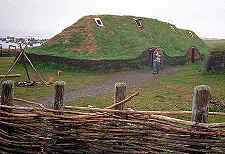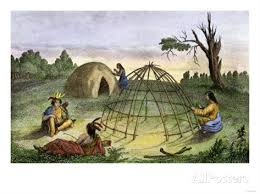Why did the Age of Exploration that eventually led to the European settlement of the Berkshires begin in the 1400’s? Fear, greed and new technology.
Before There Were Pilgrims – Early European Explorers
Vikings Probably Earliest Europeans
The first Europeans to get remotely close to Massachusetts were probably Vikings from Iceland. There is archaeological evidence of a 1,000 year old Viking settlement at L’Anse Aux Meadows in northern Newfoundland. No permanent settlement survived. They may have come earlier, but the first records of European stopovers in the search for Cod and whales are from the 16th century.
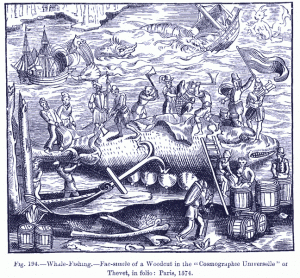
European Fisherman and Explorers by the 16th Century
European travel to and around Massachusetts picked up to near traffic jam levels by the 16th century. A rush for a Northwest passage to the Orient and gold starting in earnest with Columbus’s return to Europe from his 1492 voyage. It was thrown into high gear after Pissaro’s conquest of the Incas and their gold in 1532. Continue reading Before There Were Pilgrims – Early European Explorers
Henry Hudson Near the Berkshires in 1609
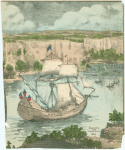 There’s no evidence that anyone from Henry Hudson’s expedition was any closer to the Berkshires than the Hudson River. But it is very likely, tales of the wondrous craft, “a great floating bird,” seen going up the Hudson as far as Albany would have spread like wildfire among the various tribes living anywhere near the river in the early 17th century. There also might have been enough contact tp touch off the small pox epidemic that had decimated tribes on both sides of the river by 1he 18th century.
There’s no evidence that anyone from Henry Hudson’s expedition was any closer to the Berkshires than the Hudson River. But it is very likely, tales of the wondrous craft, “a great floating bird,” seen going up the Hudson as far as Albany would have spread like wildfire among the various tribes living anywhere near the river in the early 17th century. There also might have been enough contact tp touch off the small pox epidemic that had decimated tribes on both sides of the river by 1he 18th century.
Life in the Berkshires Before Europeans
From their earliest explorations of North America, Europeans influenced (and generally not for the better) North American native life. So, by the time early Berkshire settlers encountered Native Americans, Indian lifestyle had already been drastically altered. Therefore, observations of even the earliest Europeans speculation to get any picture of life in the Berkshires prior to the earliest (1400-1600 CE) European encounters in NorthAmerica requires some speculation.
Ancient Native American Civilizations
By 6,000 BCE post ice-age North American environment had changed – forests had replaced the barren tundra left by the glaciers and the massive early animals had been replaced by more of the smaller animals we see today. Indications are that the inhabitants were adapting to these different food sources culminating in various forms of agriculture and a – still migratory – but more settled form of life.
With increased control of food sources, population on the continent is estimated to have approached a million by 2500 BC (roughly simultaneous with the earliest Egyptian civilizations).[i]
When Did People First Come to the Berkshires?
How long have there been people in the Berkshires? Hard to know but based on a recent lecture sponsored by Bidwell House there is evidence we had tourists as long as 4,000 years ago.
Uncovering signs of life at Kampoosa Bog
By Jess Gamari, Berkshire Eagle Staff
Posted: 07/22/2013 05:05:04 PM EDT
Updated: 07/23/2013 11:15:39 AM EDT
TYRINGHAM — Before Puritan settlers landed on Plymouth Rock, and before Columbus sailed, Berkshire Country residents were already hunting and maintaining gardens.
On Saturday, Eric Johnson, archaeology lecturer at the University of Massachusetts at Amherst, gave a talk at the Tyringham Union Church about 4,000-year-old findings from an expedition to the Kampoosa Bog.
The Kampoosa Bog in Stockbridge is a dark and swampy lake surrounded by an old growth forest of hemlock, beech and hickory trees. The bog came into existence in the wake of the melting glacial ice, Johnson said, which dates back to about 12,000 years ago. Continue reading When Did People First Come to the Berkshires?
More on Windsor Mountain School
Roselle Charlock gave a talk Oct. 30, 2014 at the Lenox Library which rounded out the information from Rick Goeld on Windsor Mountain School. Rosalie’s talk provided an introduction to her new book, Windsor Mountain School, A Beloved Berkshire Institution. Roselle is professor emerita of education at the Massachusetts College of Liberal Arts and the author of several books on education and on the Holocaust.
Progressive Education at Windsor Mountain with a European Flair
Her book provided additional information on the Bondy family (the founders of Windsor Mountain School) and their educational philosophy. Max Bondy had a background with the German Youth Movement which, before it was co-opted into Hitler Youth, stressed healthy outdoor living which Max and other faculty members brought to Windsor Mountain School. Their educational philosophy also emphasized learning to control violent, destructive impulses natural to all of us by experiential learning, artistic expression, and a self-defined path. Freedom was seen as key to a self-defined life. Continue reading More on Windsor Mountain School
Festival House Lenox 1950-1961
From 1950 to 1961 Bruno and Claire Aron owned what is now Ventfort Hall and ran it as a hotel for culture oriented travelers of all races and religions. Festival House was a precursor of many attitudes and activities important to Lenox today.
Claire and Bruno Aron
Claire and Bruno were first generation Americans in a family of Eastern European Jewish heritage.
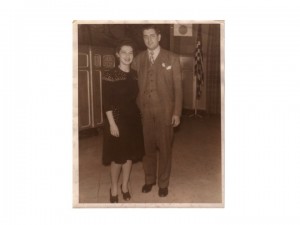
They both loved culture and were very concerned with social justice. Bruno left his job at the Pittsfield Jewish Community Center in 1949 and started looking for other opportunities in the Berkshires. Bruno and his family loved the beauty of the Berkshires and wanted to increase opportunities for others to visit. While working at the Pittsfield Jewish Community Center, Bruno was often contacted by Jews traveling to Tanglewood about where they could stay when attending concerts, so he was aware of the discriminatory practices of some lodgers at the time and wanted to create a place that would welcome all visitors. Demonstrating foresight on what was to come, he and Claire also envisioned leveraging the attractions of Tanglewood to make the Berkshires a cultural destination.
Gilded Age Coaching
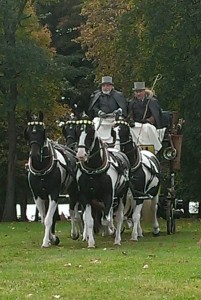
The Gilded Age returns to Elm Court in Lenox October 10, 2014
Earliest American Arrivals – Crossover the Bridge
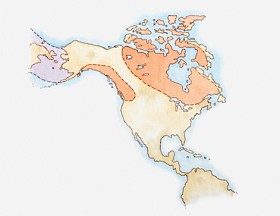
The most widely accepted theory is that the earliest visitors to North America (and eventuall our area) followed their hunting quarry over a land bridge from Asia to Alaska. Perhaps 15,000 years ago ice sheets had tied up enough water that sea levels had dropped as much as 300 feet. Following game around the edge of the retreating ice sheets, these wanderers would eventually reach the Berkshires. There is evidence of paleo-Indian inhabitants in Massachusetts 9,000-10,000 years ago[i] – consistent with these overall continental migrations. The ice sheets would have scrubbed off most vegetation, but these early arrivals would probably have been following and dinning well on giant, slow moving and now extinct game such as Mastadons and Woolly Mammoths.
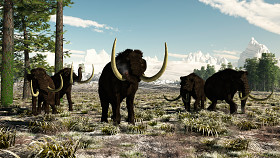
Initially they probably conducted themselves in the new land similarly to the way they conducted themselves in Siberia. They probably would have traveled in small bands of 15-50 using spears to hunt game including many large animals now extinct – mammoths, mastodons – as well as caribou, moose and the deer still here today. Archaeological evidence shows evidence of transient settlement at water holes where the game they sought would have congregated. The extinction of most of the giant beasts that originally occupied the continent may have been related to climate change, but surely these wiley new bipeds played a part as well. In any case the sweeping plains and easy, massive kills eventually disappeared.
[i] Bidwell House talk on Kampoosa Bog, Chapter 2 – Massachusetts 101
For more information see:
American Colonies: The Settling of North America, by Alan Taylor; The Penguin History of the United States; Eric Foner, editor;2002; Published by Penquin Books USA, 375 Hudson Street, NY, NY 10014, Lincoln DExter (need pub data), Extinct animals (need pub reference)
Formation of The Berkshires – The Ice Age
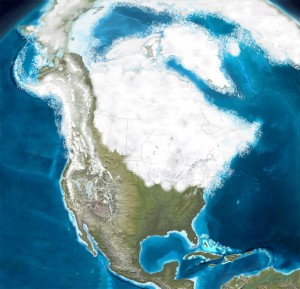
Throughout the millennia, the earth has gone through long periods of warming and cooling. The entire Pleistocene Epoch – beginning about 2MM years ago was marked by invasions of massive glaciers interrupted by warming periods. Dating of the most recent glacial advance varies but is usually described as reaching its farthest extent 20-30,000 years ago. New York and New England were, by about that time, covered by grey glaciers that were up to 10,000 feet deep.
Leveled Peaks and Created Lakes
In its retreat (beginning about 18,000 years ago) it left imprints in any softer surface. Some of these filled with melting ice including what was a large lake (from 1-12 miles wide) in the middle of the state until 2-3,000 years ago. Many of our ponds and lakes are the residual of these depressions filled with water. On a grander scale, the retreating glaciers carved out north/south valleys and ridges which finalized the layout of our hills today. [i]
What would have been left behind as the Earth warmed on Berkshire county would be marshy tundra for thousands of years.
Land Bridge
It sucked up enough moisture to lower sea levels by as much as 300 feet and wiped out any plant and animal life that had existed before.
Meanwhile, as a result of the lowered sea levels, paleo man is thought to have crossed what is now the Bering Straits from Asia to North America about 15,000 years ago and to have fanned out across the continent as the ice retreated. The earliest remains found in Massachusetts are dated at about 9,000 years ago.[i]
[i] Maps of Early Massachusetts, by Lincoln Dexter, New England Blue Print Company, 1979 – pgs 5-12

